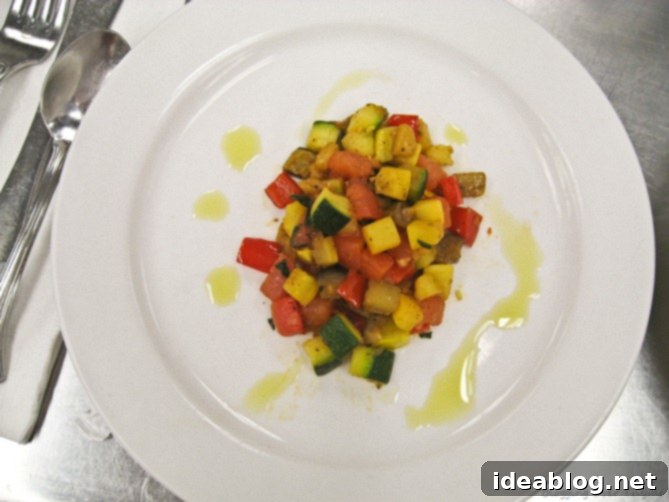Mastering Classic French & Asian Cuisine: A Culinary School Journey Through Coq Au Vin, Ratatouille, Tarte Tatin, and Dim Sum
Despite a challenging start to Thursday morning, involving an unexpected traffic jam on the way to culinary school (which I thankfully navigated around), the day unfolded smoothly and proved to be incredibly enriching. It was a day filled with diverse culinary explorations, from the rustic elegance of French classics to the intricate flavors of Asian specialties, offering a profound dive into various cooking techniques and global cuisines.

The star of our French repertoire for Thursday was undoubtedly Coq Au Vin, a timeless dish celebrated for its rich, complex flavors. We initiated the preparation the day prior by breaking down and marinating the chicken in class. Historically, Coq Au Vin was conceived as a method to tenderize and flavor older roosters or hens, which were typically tougher and gamier than the broiler chickens we commonly use today. The extended marinating process was crucial then, and remains a vital step now, to infuse flavor and achieve optimal tenderness in the meat.
Our morning lecture provided an insightful overview of the fundamental principles behind marinades, detailing their three primary purposes:
- Tenderization: This is achieved through the use of culinary acids such as wine, vinegar, or citrus juices. These acids help break down the connective tissues in meat, making it more palatable and tender.
- Flavor Enhancement: Marinades are excellent vehicles for introducing aromatic compounds, herbs, and spices into the meat. Ingredients like garlic, onions, peppercorns, and fresh herbs penetrate the surface, adding depth and complexity.
- Enrichment: The addition of a fat component, such as olive oil, not only contributes to the flavor profile but also helps to retain moisture during the cooking process, resulting in a juicier final product.
The precise ratio of these components in a marinade should always be tailored to the type of meat being prepared. Tougher cuts, like those from older fowl or certain game meats, benefit significantly from a higher proportion of acid for effective tenderization. Conversely, more tender cuts, such as chicken breasts or pork tenderloin, require less acid but may benefit from additional fat to enhance richness and prevent drying out during cooking.
Our specific marinade for Coq Au Vin was a sophisticated blend, featuring robust red wine, a classic mirepoix (diced carrots, celery, and onions), a fragrant bouquet garni (fresh thyme, whole peppercorns, parsley stems, and a bay leaf), delicate orange segments for a subtle citrus note, pungent clove, and aromatic garlic. This combination created a deep, flavorful base for our chicken.
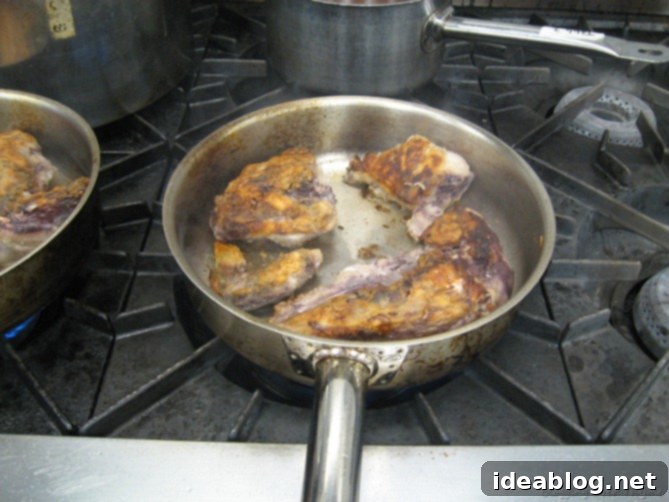
To execute our Coq Au Vin, we carefully removed the bone-in chicken pieces from the marinade, patted them dry, and lightly dusted them with flour. This flour coating aids in achieving a beautiful, golden-brown crust when seared in a very hot pan, which is crucial for developing flavor through the Maillard reaction. Once perfectly seared, the chicken pieces were set aside to make way for the next steps in building the sauce.
The pan, now imbued with rich fond (the flavorful browned bits left after searing), was drained of any excess fat. We then deglazed the pan with the marinade’s mirepoix, scraping up all those delicious bits from the bottom, and stirred in a small amount of tomato paste for an added layer of umami and color. This mixture was deglazed once again with a generous splash of red wine, also from our marinade, intensifying the sauce’s depth. Finally, veal stock was introduced, and all the seared chicken pieces were returned to the pan. A crucial technique we learned was to reserve the chicken breasts, as they cook much faster and can dry out if added too early alongside the drumsticks, thighs, and wings.
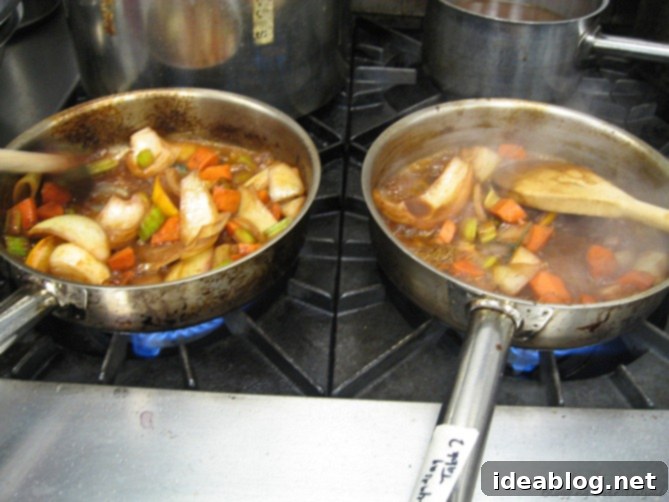
The pan was then covered with a cartouche, a parchment paper lid pressed directly onto the surface of the liquid, which helps maintain moisture and even heat distribution during the slow braising process. It was placed into a 300-325 degree Fahrenheit oven until the chicken was thoroughly cooked. Approximately 30-40 minutes into the cooking time, the reserved chicken breasts were added to ensure they reached perfect doneness without becoming dry. Just before serving, the chicken was carefully removed, and the sauce was strained to achieve a silky-smooth consistency. This straining step is almost always performed, as the mirepoix and bouquet garni have served their purpose by imparting their full flavor to the sauce.
The traditional garnishes for Coq Au Vin are meticulously prepared and cooked separately before being combined with the rich sauce and tender chicken. These include quartered and sautéed mushrooms, savory bacon cut into lardons (small 1/2-inch rectangles of rendered pork belly), and sweet glazed pearl onions. Each component adds a distinct texture and flavor, contributing to the dish’s overall harmony. We served this magnificent Coq Au Vin alongside a simple yet elegant rice pilaf, allowing the robust flavors of the chicken to shine.
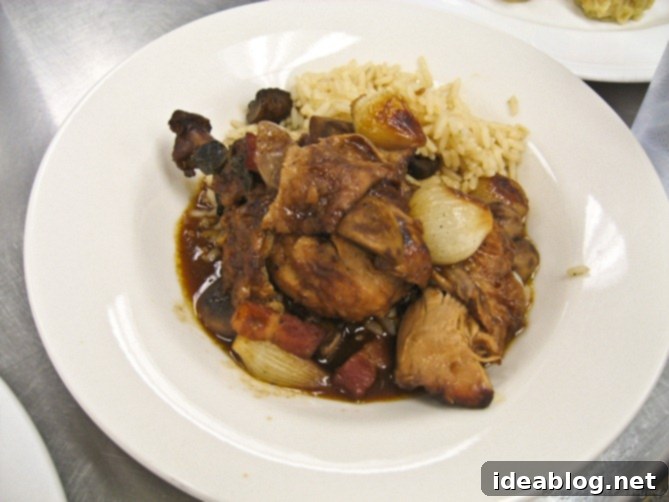
Coq Au Vin – perhaps not the most photogenic dish, but undeniably delicious. The meat was so tender it was literally falling off the bone!
To complement our rich Coq Au Vin, we ventured into preparing Ratatouille for the first time. This vibrant, classic Provençal dish is a celebration of fresh garden vegetables, typically featuring red bell pepper, yellow squash, zucchini, ripe tomatoes, sweet onions, and earthy eggplant. We further enhanced its flavor profile with fragrant garlic and delicate chiffonade basil, adding a fresh, herbaceous finish.
While seemingly simple, Ratatouille demands meticulous knife skills, as each vegetable component is meant to be cut into nearly identical sizes, ensuring even cooking and a beautiful presentation. A key technique in its preparation involves cooking each vegetable separately to its optimal doneness, allowing its individual flavor and texture to develop fully, before gently tossing them together just before service. This method preserves the integrity of each ingredient, preventing a mushy outcome. It’s impossible for me to think of this dish now without recalling the delightful Pixar movie, which beautifully captures the essence and charm of this humble yet elegant vegetable medley. The final dish, with its medley of colors and artistic drizzles of olive oil, was truly a joy to plate and admire.
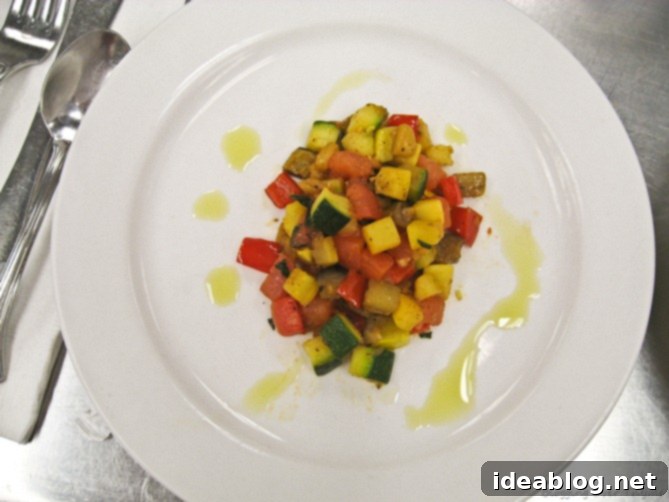
For our dessert, we crafted Tarte Tatin, another iconic French classic renowned for its caramelized apples and buttery crust. Our individual portions were made using small blue-steel pans, where we first created a simple, luscious caramel directly in the pan. Into this bubbling caramel, we carefully nestled cored and quartered apples, ensuring they were evenly coated and began to soften.
The apples were then elegantly covered with discs of leftover, pre-docked puff pastry, which helps prevent the pastry from puffing up too much during baking. The assembled tartlets were placed in the oven to bake until the pastry was golden and crisp, and the apples were tender and deeply caramelized. This delightful dessert can also be made with other types of pastry, such as pâte sucrée for a sweeter, more delicate crust, or pâte brisée for a flakier, savory-leaning option, showcasing its versatility. The result was incredibly delicious, with a perfect balance of sweet, tart, and buttery flavors.
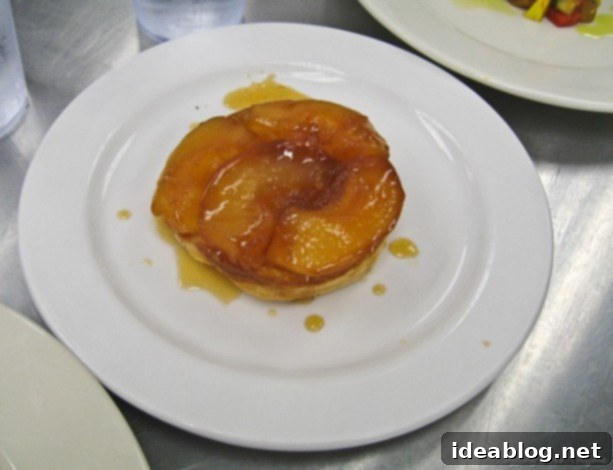
Adding a delightful surprise to our French-focused day, and thanks to Chef Somchet’s passion for introducing us to a wide array of global cuisines, we also had the opportunity to learn how to make traditional Dim Sum. These little culinary parcels were incredibly delicious, and I’m genuinely excited to recreate them at home. I definitely plan to share the recipe once I’ve perfected it, as the process is surprisingly simple and straightforward.
Our Dim Sum filling was a vibrant combination of flavorful ground pork (emphasizing the importance of at least 30% fat content for succulence) and finely chopped raw shrimp, which added a delightful springy texture. This base was enriched with finely diced mushrooms, fresh green onions, fragrant ginger, and a medley of other traditional seasonings that brought all the flavors together. The golden rule for enjoying Dim Sum, as we quickly learned, is to consume them straight from the steamer – piping hot to truly savor their delicate flavors and textures.
Even at 8:30 in the morning, during our demonstration, these savory dumplings tasted absolutely wonderful! I’ve truly appreciated the chance to delve deeper into Asian dishes, an area where I feel I have the most to learn and experience. The anticipation is building for an entire Asian Day menu scheduled for the near future—I am incredibly excited for that immersive culinary experience!
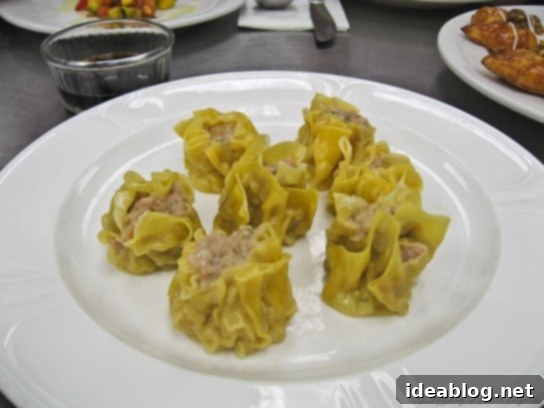
I hope everyone is enjoying a fantastic weekend! And, of course, for those celebrating, I hope you’re preparing (or indulging in) lots of fantastic food for the Super Bowl. While football might not be my main passion, I certainly relish the opportunity to create delicious food for any occasion, especially one that brings people together around the table. This culinary journey continues to inspire me with every new dish and technique mastered.
